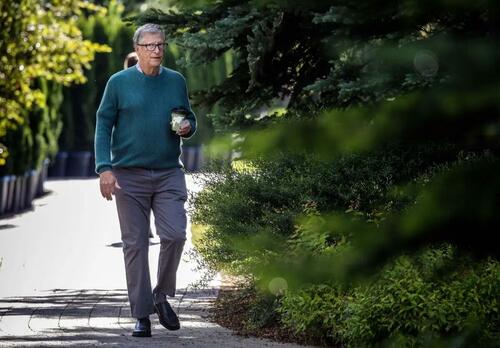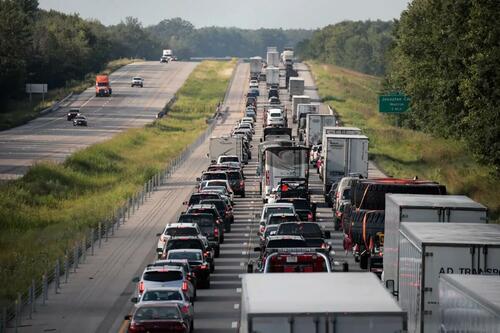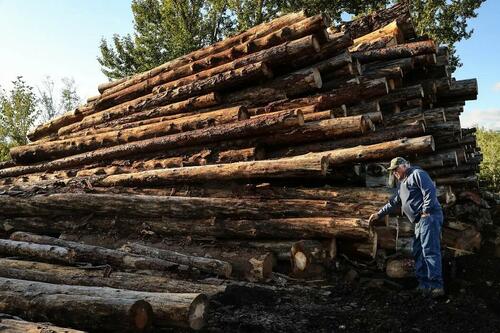"I mean, are we the science people, or are we the idiots?"
Authored by Autumn Spredemann: Cutting down trees to manage wildfires isn't a new thing, although it remains a hotly debated practice.
Tree thinning is a disputed procedure that has drawn as much criticism within the environmental community as support. Many scientists, researchers, and conservationists are against it, saying tree thinning can even worsen wildfires.
However, America's woodlands have been culled for more than two decades for fire management. Now, climate activists are jumping into the conversation with a "carbon capture" argument for tree thinning.
Activists such as Microsoft co-founder Bill Gates have thrown their weight, and checkbooks, behind the practice of cutting down trees and burying them to address fears over carbon emissions.
Through his foundation Breakthrough Energy Ventures, Mr. Gates is a part of the $6.6 million seed investor pool backing Kodama Systems in its proposal to remove trees in California's fire-challenged woodlands and bury them in Nevada to sequester carbon dioxide (CO2).
"We must dramatically accelerate forest thinning treatments," the Boston-based firm says on its website. Kodama calls itself a "technology-driven forest restoration service."
Mr. Gates is well known for his headline-grabbing methods of addressing his climate concerns—from buying up vast swaths of U.S. farmland to backing wild-card experiments such as solar geoengineering and, most recently, criticizing tree planting as a viable means of reducing CO2.
During The New York Times Climate Forward Summit in September, the billionaire didn't hesitate to share his thoughts on the role of planting trees to mitigate climate concerns, calling it "complete nonsense."
In an interview with NY Times reporter David Gelles, Mr. Gates responded dismissively to the idea that planting more trees can reverse adverse climate effects.
"That's complete nonsense ... I mean, are we the science people, or are we the idiots?" Mr. Gates asked rhetorically.

Critics are quick to point out holes in the logic surrounding the claimed benefits of culling trees and burying them.
"This is a spectacularly bad and counter-productive idea," Chad Hanson, a research ecologist and co-founder of the John Muir Project, told The Epoch Times.
He says existing trees and forests are "by far, our best and most effective means" to reduce any "excess of carbon in our atmosphere."
Additionally, selective culling poses a risk to old-growth trees, which research indicates capture vastly more atmospheric carbon than their younger counterparts.
Living trees store a massive amount of atmospheric carbon. One estimate puts the CO2 storage value of U.S. forests and grasslands at 866 million metric tons per year. For perspective, that equates to the annual emissions from 50 million gasoline- or diesel-fueled vehicles.

Some research does support the theory that burying debris from cut trees can work as a form of carbon capture. One 2019 study showed that storing wood biomass can remove billions of tons of carbon annually.
"Trees continue to sequester and store more and more carbon as they get older, and this is true no matter how old they get,” Mr. Hanson said in countering that point. “Cutting existing trees and burying them eliminates their ability to draw down and reduce atmospheric carbon."
No in-depth analysis exists on the asserted benefits or secondary environmental effects of tree thinning and debris storage.
"Research related to sustainability in the field of social and environmental impacts of carbon capture has not been done enough and this field of studies is still immature," a study published in Science Direct states.
On its website, Kodama Systems notes that carbon accounting frameworks are being developed, but didn't offer further details.
Representatives of Kodama didn't respond to a request by The Epoch Times for comment.

The argument to leave mature forests and dense canopy intact—strictly for CO2 sequestration—has support from top scientific researchers.
William Moomaw, founding director of the Center for International Environment and Resource Policy at Tufts University’s Fletcher School of Law and Diplomacy, is among what he calls the "proforestation" school of thought on storing atmospheric carbon.
He’s an avid supporter of the planting of trees and advocates for leaving older and middle-aged forests alone, because of their superior carbon storage abilities.
"The most effective thing that we can do is to allow trees that are already planted, that are already growing, to continue growing to reach their full ecological potential, to store carbon, and develop a forest that has its full complement of environmental services," Mr. Moomaw said during a 2019 interview with Yale Environment 360.
"Letting existing natural forests grow is essential to any climate goal we have."
Culling to Mitigate Fire Risks
Tree thinning also has a debatable track record in wildfire management, but has a growing bench of supporters in the public and private sectors.
The U.S. Forest Service has made selective tree culling a critical part of its 10-year plan for wildfire management.

Officials hope to use the method on millions of forested acres by 2030.
"We estimate that a total of 50 million acres of forests in the U.S. need hazardous fuels and forest health treatments to address the growing wildfire crisis," U.S. Forest Service spokesman John Winn told The Epoch Times.
He said 20 million of the acres are on national forests and grasslands, and 30 million acres are on other lands.
"Nearly a quarter of the contiguous U.S. remains at moderate to very high risk of severe wildfires," Mr. Winn said.
He said some studies support tree thinning as a tool in forest fire mitigation.
Source
No comments:
Post a Comment